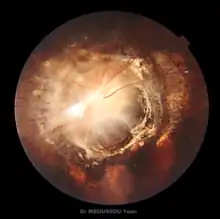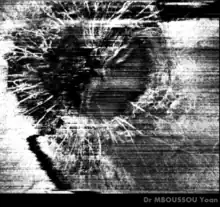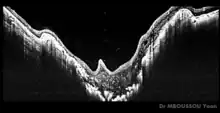Morning glory disc anomaly
The morning glory disc anomaly (MGDA) is a congenital deformity resulting from failure of the optic nerve to completely form in utero.[1] The term was coined in 1970 by Kindler, noting a resemblance of the malformed optic nerve to the morning glory flower.[2] The condition is usually unilateral.[3]


Presentation
Complications
Serous retinal detachment can occur in the affected eye.[4]
Associated conditions
Although the finding itself is rare, MGDA can be associated with midline cranial defects and abnormal carotid circulation, such as carotid stenosis/aplasia or progressive vascular obstruction with collateralization (also known as moyamoya disease).[4] The vascular defects may lead to ischemia, stroke, or seizures and so a finding of MGDA should be further investigated with radiographic imaging.
Diagnosis
On fundoscopic examination, there are three principal findings comprising the anomaly:[5]
- an enlarged, funnel-shaped excavation in optic disc
 Morning glory syndrom OCT
Morning glory syndrom OCT - an annulus or ring of chorioretinal pigmentary changes surrounding the optic disc excavation
- a central glial tuft overlying the optic disc
See also
References
- ↑ Magrath, GN; Cheeseman EW; Sarrica RA (2013). "Morning Glory Disc Anomaly". Pediatric Neurology. 49 (6): 517. doi:10.1016/j.pediatrneurol.2013.05.015.
- ↑ Kindler (1970). "Morning glory syndrome: unusual congenital optic disk anomaly". Am J Ophthalmol. 69 (3): 376–84. doi:10.1016/0002-9394(70)92269-5.
- ↑ Barnard, Simon. "An Introduction to Diseases of the Optic nerve". Retrieved 30 May 2014.
- 1 2 Quah, BL; Hamilton J; Blaser S; et al. (2005). "Morning glory disc anomaly, midline cranial defects and abnormal carotid circulation: an association worth looking for". Pediatr Radiol. 35 (5): 525–528. doi:10.1007/s00247-004-1345-y.
- ↑ Auber, AE; O’Hara M (1999). "Morning glory syndrome. MR imaging". Clin Imaging. 23: 152–158. doi:10.1016/s0899-7071(99)00118-7.